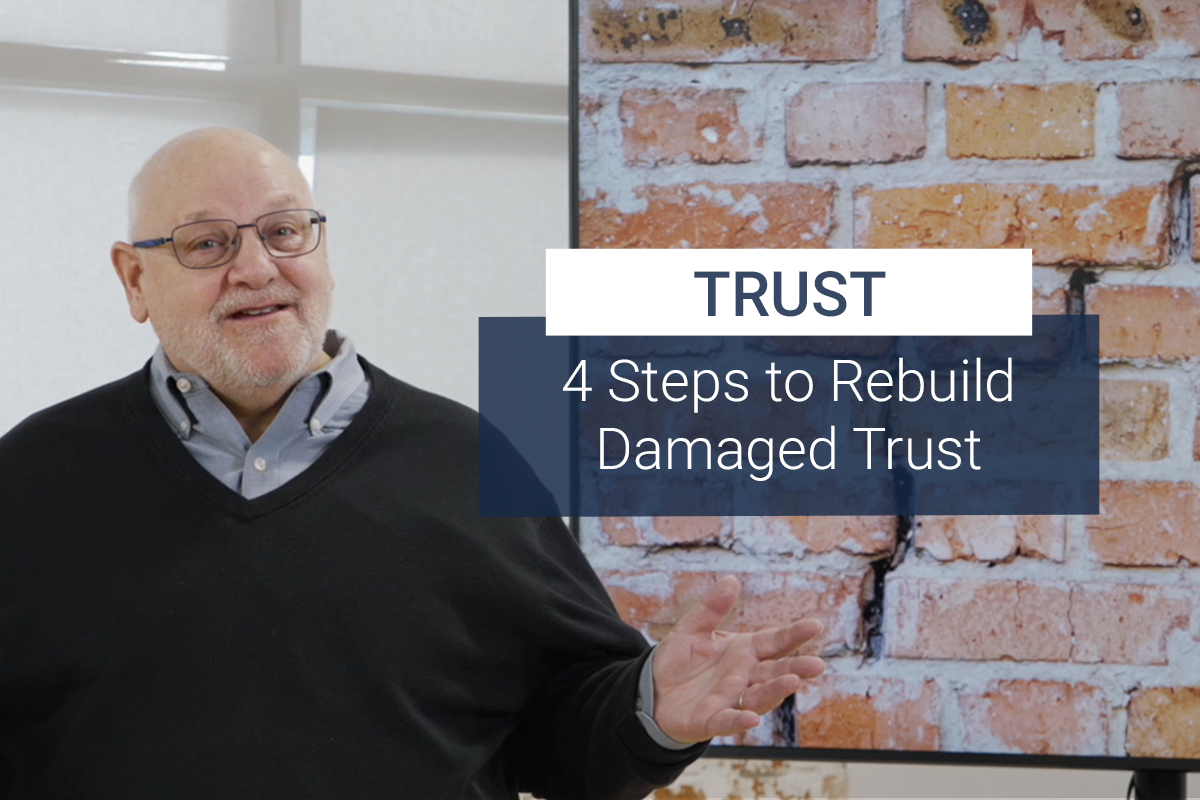When a brick wall starts to crack, there are internal and external pressures working on it. Like the old saying, “A stitch in time saves nine,” you need to fix the crack immediately or you will have greater expenses and greater damage.
The same is true for trust. Here are four steps to rebuild damaged trust.
1. Be perceptive and proactive.
Being perceptive means you are aware – you are aware if you are receiving signals that people distrust you like leaving you out of conversations or holding back information. These are signs you should proactively seek out those you may have affected through an act of distrust or an act that breached their confidence in you.
So, be perceptive and aware, read body language, and read team dynamics. If there has been a violation of trust, perceive it, and then quickly do something about it. Be proactive and don’t wait until somebody confronts you.
2. Take full responsibility for your actions and apologize.
In other words, be quick to own it. We often refer to this as extreme ownership or blameless resolution. “I’m going to own it completely. I’m going to come to you and say what I have done that has violated your trust.” They may be surprised, but your trust will increase. Validate that there could be feelings of betrayal. Identify that they may have to give you time to rebuild that trust. If you violate the trust of one person, go to that person. If you have had a breach of trust with a group, go to the group. Don't leave those things undone. The crack will just get bigger and bigger, and the foundation of trust, which is essential for teams, will get weaker and weaker.
3. Show heartfelt remorse and regret.
You might think “remorse” and “regret” are synonyms, but they are not. When somebody has remorse, “I am sorry for what I did to you,” they are owning the betrayal and broken trust in a heartfelt way. They are not just going through the motions and making a formal apology. They are not just sending an email with a generalized message, “I’m sorry.” No, they are authentically and sincerely saying, “I hurt you. I disappointed you. I let you down. I let us down as a team.”
Regret has to do with how it affects the person who caused the breach of trust. “I’m really sorry that I did this to you, and I’m also sorry for what I did to me. I broke down the trust that I worked hard to build, and I have diminished your ability to trust me. And that hurts me. That hinders me from being trusted with even greater things.”
4. Repent to restore.
Finally, repent to restore. To repent means to have a change of heart and to make a decision to do something differently. To restore means to go about the work of repairing.
Using the brick wall as an example, to repent you might say, “I feel so badly I ran into the brick wall with my car. I’m never going to do that again. I learned some real lessons. Don’t accelerate heading towards the brick wall.” You recognize that there was a transgression, and you did something that broke the trust. Or, in this case, you cracked the wall. Repentance is the commitment that you will learn from this mistake.
To restore, you might say, “I’m going to repair it, and I’m going to do it the right way.” Restoring means you will try to do whatever needs to be done to repair what you did and restore the person who was hurt by your breach of trust. When restoring, you want it to be as good or better than it was before.
And so, I hope that when you repent, you will take the actions to restore and then keep monitoring because trust is quick to be lost, but it builds systematically through a series of actions that bring confidence and trust.
Contact us to learn how our experienced coaches can help you create a culture of trust in your business, church, or nonprofit organization.
Dave Marks serves as Vice President and Senior Consultant at The Center Consulting Group, bringing over 35 years of church ministry experience, including 23 years as a senior pastor. He holds an M.S. in Organizational Leadership and a D.Min. in Leadership. Dave partners with church and nonprofit leaders to resolve conflict and restore relationships, build high-performing teams, analyze and strengthen organizational culture, and educate and train staff and volunteers. Dave is passionate about coaching others towards organizational and leadership health, and refining systems and processes for sustainable growth. His holistic approach integrates strategic planning, leadership development, and organizational diagnostics to help ministries thrive in every season. An avid follower of NASCAR and Indy Racing, Dave brings the same passion and precision from the racetrack to every consulting engagement.




![Public Speaking: Using AI Ethically & Effectively to Create a Powerful Speech [VIDEO]](https://images.squarespace-cdn.com/content/v1/571fc0ea1d07c0fd6d72c167/1763735597032-XMIKMQ1D63PRC1QJ6FVV/ai+speech+blog.png)
![Preparing for the (Expectedly) Unexpected [VIDEO]](https://images.squarespace-cdn.com/content/v1/571fc0ea1d07c0fd6d72c167/e4193bcf-29f7-46c2-be12-9116791d40cf/unexpected+blog.png)
![Fundraising: How to Raise Funds for Your Nonprofit [VIDEO]](https://images.squarespace-cdn.com/content/v1/571fc0ea1d07c0fd6d72c167/1757619882819-6OARWR0QU11M7LA0ABYL/fundraising+blog.png)
![Culture: 5 Traits That Set Healthy Churches & Their Leaders Apart [VIDEO]](https://images.squarespace-cdn.com/content/v1/571fc0ea1d07c0fd6d72c167/1755633039402-KVJFNJWG0RKBCMLS5FNB/healthy+blog.png)
![Vision: 3 Must-Have Traits of Every Successful Visionary Leader [VIDEO]](https://images.squarespace-cdn.com/content/v1/571fc0ea1d07c0fd6d72c167/1749484247758-ITEGD2LZZ716112KLHXZ/visionary+blog.png)
![Advisory Boards: Should Your Business Have an Advisory Board? [VIDEO]](https://images.squarespace-cdn.com/content/v1/571fc0ea1d07c0fd6d72c167/1747149791510-HU20SY0O8LRPEHGMC6HD/advisory+blog.png)
![Leadership: How to Be a World Class Boss [VIDEO]](https://images.squarespace-cdn.com/content/v1/571fc0ea1d07c0fd6d72c167/1744640489138-X5LUNZT3JTRQYSSZXV1C/boss+thumbnail.png)
![Conflict: The Importance of Having Tough Conversations [VIDEO]](https://images.squarespace-cdn.com/content/v1/571fc0ea1d07c0fd6d72c167/1741365599296-KTWEJ5PTNH1BX2GJ9REJ/Conversations+blog.png)
![Exit Planning: The Challenge of Business Exit Planning & Why It Matters to You [VIDEO]](https://images.squarespace-cdn.com/content/v1/571fc0ea1d07c0fd6d72c167/1738339040891-VIW87N2NCZUCKLYNOHB6/exit+blog.png)

![Teams: Is Your Team Dysfunctional? [VIDEO]](https://images.squarespace-cdn.com/content/v1/571fc0ea1d07c0fd6d72c167/1733243870005-NOI69Z74DLNVLIB8MRRJ/dysfunctional+blog.png)
![How to Recruit and Inspire Volunteers [VIDEO]](https://images.squarespace-cdn.com/content/v1/571fc0ea1d07c0fd6d72c167/1728421227208-6JAUFVXEJW5KK6YE58JR/volunteers+blog.png)
![Trust: 4 Steps to Rebuild Damaged Trust [VIDEO]](https://images.squarespace-cdn.com/content/v1/571fc0ea1d07c0fd6d72c167/1725969594417-7AN9PJO2X8TTR77ACDFP/trust+blog.png)
![Blind Spots: How to Identify & Avoid Blind Spots in Your Organization [VIDEO]](https://images.squarespace-cdn.com/content/v1/571fc0ea1d07c0fd6d72c167/1722610352594-FAXECLPC61QYJH2I5YT8/blind+spot+blog.png)
![Family Business: Will the Family Business Destroy Our Family? [VIDEO]](https://images.squarespace-cdn.com/content/v1/571fc0ea1d07c0fd6d72c167/1718027719043-MU9AYPTQ7GM4XWT9EGD1/destroy+blog.png)
![Teams: How to Breathe New Life into a Broken Team [VIDEO]](https://images.squarespace-cdn.com/content/v1/571fc0ea1d07c0fd6d72c167/1714749389916-G2CWVK8OM1JJSD9058CL/breathe+blog.png)
![Planning: The Power of Planning [VIDEO]](https://images.squarespace-cdn.com/content/v1/571fc0ea1d07c0fd6d72c167/1712597764732-WHRZPRLZ6V78CBGKBPZA/PLanning+blog.png)
![Leveling Up Your Leadership: Becoming an Effective Senior Leader [VIDEO]](https://images.squarespace-cdn.com/content/v1/571fc0ea1d07c0fd6d72c167/1710266273593-QN3HEBJ5FII4GKQFH91Q/leveling+up+blog.png)
![Recruiting & Retaining “Mature” Team Members [VIDEO]](https://images.squarespace-cdn.com/content/v1/571fc0ea1d07c0fd6d72c167/1707849950823-Y5WJLYXM6ZPU55TKG27Y/recruitment+blog.png)

![Gaslighting: How to Identify It & Take Back Control [VIDEO]](https://images.squarespace-cdn.com/content/v1/571fc0ea1d07c0fd6d72c167/1699381799669-Y6XNYG2X3ZD1US80XAFY/Gaslighting+blog.png)
![Decision-Making: Why Smart Leaders Do Dumb Things [VIDEO]](https://images.squarespace-cdn.com/content/v1/571fc0ea1d07c0fd6d72c167/1696947285846-ZIA5M26B5AF9SRFGWFPV/Dumb+Things+blog.png)

![Meeting Effectiveness: 4 Different Types of Meetings & Why It Matters [VIDEO]](https://images.squarespace-cdn.com/content/v1/571fc0ea1d07c0fd6d72c167/1690296011536-23CWWE2VJ40QJ0UA1EZY/meetings+blog.png)
![Leadership: 4 Directions You Need to Lead [VIDEO]](https://images.squarespace-cdn.com/content/v1/571fc0ea1d07c0fd6d72c167/1689105063370-WQTIN47T3TP8YXQM3RMP/directions+blog.png)
![Leadership Model: Are You a Cheerleader, Drill Sergeant, or Coach? [VIDEO]](https://images.squarespace-cdn.com/content/v1/571fc0ea1d07c0fd6d72c167/1686670057921-DJ286QE8OZOQKE22SZAL/coach+blog.png)
![Developing Women Leaders: The Power of Leader Efficacy [VIDEO]](https://images.squarespace-cdn.com/content/v1/571fc0ea1d07c0fd6d72c167/1683572272369-EJ4N7BBXL0832YUM4XUN/Women+efficacy+blog.png)


![Innovation: How To Make Innovation Part of Your Leadership [VIDEO]](https://images.squarespace-cdn.com/content/v1/571fc0ea1d07c0fd6d72c167/1675365017628-0ZAPR2WCAM23JVDHM34I/Innovation+blog.png)